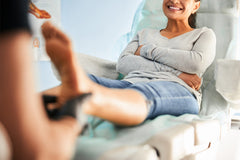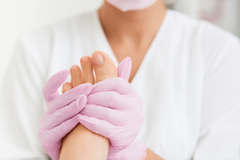Add These Tips to your Footcare Routine This Fall

by Dr. Emily Splichal, DPM MS
Shorter days and cooler weather mean that autumn is upon us. As we transition into the fall and winter months, for many this means it is time to put away the summer sandals and pull out our favorite boots.
This change in seasons is the perfect time to check in with your footcare routine and kick off some new healthy habits which you may have been neglecting.

Summer weather and sandals are notorious for drying out and stressing the skin on the bottom and back of the heels. By integrating a consistent habit of moisturizing the feet at night and exfoliating weekly you can avoid the unnecessary pain caused by dry, cracked heels.
Products which contain urea or lactic acid are particularly effective at both hydrating the skin and gently debriding away thick calluses. For excessively thick calluses use an occlusion at night. This can be done by applying the hydrating cream, followed by wrapping the foot in saran wrap and wearing a sock overnight.
An additional way to exfoliate is performing a weekly mechanical debridement with a pumice stone or foot file. Always follow mechanical debridement with the hydrating foot cream.
Tip #2 – Strengthen Toenails

With our toes tucked away in closed-toe shoes, this is the perfect opportunity to take a break from the pedicures and focus on rebuilding strong and healthy nails.
Over time consistent use of nail polish can cause weakening of the nail plate, leading to brittle, dry, and fungal nails. Use these cooler months to take a “nail polish holiday” and instead of using colored polish opt for clear topical nail-strengthening lacquers that contain healthy proteins.
If any fungal infection is present in the nails, see your podiatrist discuss treatment options including topical, oral, and laser. Or if you want to go the natural route, consider taking probiotics and olive leaf extract which have been shown to reduce fungus in the toenails.
Tip #3 – Start a Foot Recovery Routine

Transitioning into fall footwear means changes in foot stress during the day. Sandals and open-toed shoes are typically wider which allows the toes to move and the feet to spread. When we go back into closed shoes and boots, our feet are going to feel the compression and restriction of movement.
Over time this more restrictive footwear can cause hammertoes, bunions, and arch pain. By implementing an evening foot recovery routine, many of these painful conditions can be avoided.
At the end of the day integrate a 5 minute foot massage and slip on some toe spacers to keep your feet feeling good.

New seasons could mean new shoes! Recent trends in footwear have shifted towards shoes that support healthy feet. Footwear that allows feet to move freely, has less structure, and is designed with a wide toe box can eliminate foot stress - and can actually strengthen feet. Various research studies have shown that wearing minimal shoes can improve foot muscle strength.
If you are new to wearing minimal footwear do ensure you follow Tip #3 and implement the daily foot recovery. There is often a period of increased foot stress when wearing minimal shoes as time is required to build up sufficient foot strength.



Leave a comment